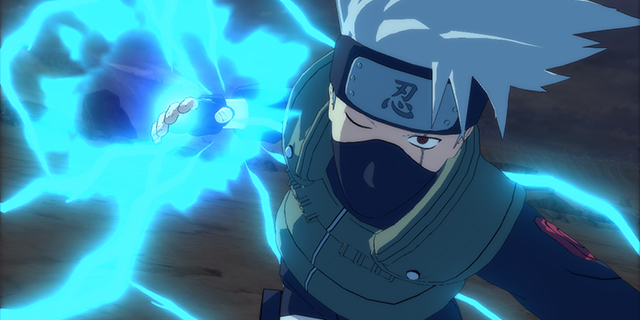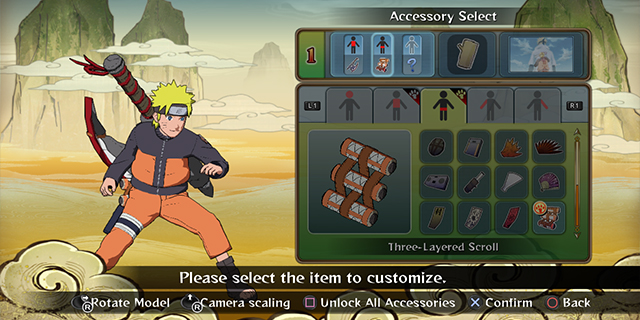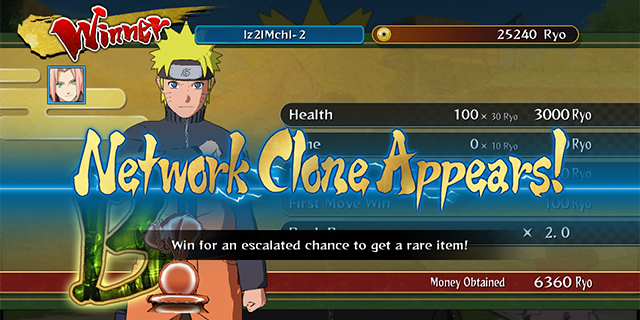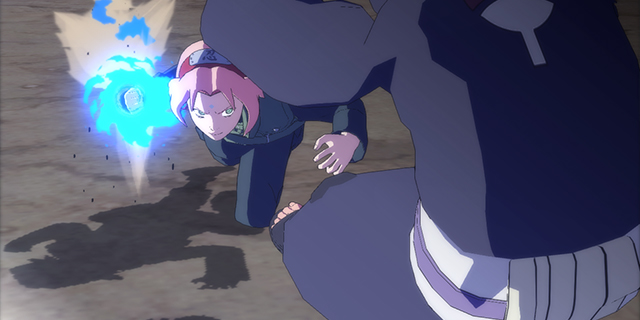
Another year, another Naruto game. Those who had their hopes pegged on this particular entry being a continuation of the story in Ultimate Ninja Storm 3 will be disappointed that this is an “in-between” game in the vein of Generations, telling side tales rather than advancing major plot points. The idea of a “Ninja World Tournament” sounds pretty cool and serves as a nice way to stuff many characters from throughout the series into one game, but does it make Revolution a good move?
In Ninja World Tournament, the game’s main new mode, you “sign a contract” to choose any default character and play through ranks from D all the way to S. Unfortunately, the story here doesn’t change depending on your character. Between matches, your character is never referred to by name or gender. Other characters keep things ambiguous by referring to you as “my friend,” making the whole experience seem a bit generic and bland.
Instead of knocking out your opponent in tournament play, you’re placed in a four-person free-for-all, fighting for battle orbs held on to by your opponents. Each round is fought with a full team of three, controlling a different character each round and collecting as many orbs as you can. At the end of the third round, whoever has the most orbs wins the match.

Between tournament matches lie the same open-world actions we’ve seen in the past games. This time around, missions earn you medals that you can use to buy accessories for your characters, as well as new allies for your tournament matches. Unfortunately, the same tedious fetch quests found in previous entries are still used. There’s only so much of following Guy’s team or tracking down Naruto within the island that you can take.
In regular matches, you’re able to use one of three different styles of play. Ultimate Jutsu Mode is the standard one, allowing you to pull off a devastating special move to heavily damage your opponent. If you’re fighting with teammates, you can perform an Ultimate Team Jutsu as well. Awakening Mode allows your character to power up for a set period of time. Drive Mode focuses more on your teammates, letting them serve as your wall on defense and help set up combos on offense. In the past entries, all characters had access to all these different modes. Thanks to the separation of the three, certain characters no longer feel overpowered and now require a little bit of strategy to put each mode to use.

Network Clone Mode is a nice feature that combines the offline Tournament Mode with some online action. These are characters you essentially mold to fight other players online without actually playing as them. Through game progression, you earn different abilities and power-ups you could equip. Sending your characters out will place them on various islands of other players, where they gain experience and occasionally bring items back. These help power up your character, depending on the play style you set for them. It’s a nice change of pace, but it could definitely be fleshed out better in future games.
Network Mode makes a return as well, but aside from your typical one-on-one matches and lobbies, there’s not much else to do. Lobby mode only allows one match to play out at a time and leaves the remaining players to just sit there while the ones fighting do their match. Online modes typically add longevity to a game, but the dearth of modes here works against that aim.
There are several small side stories featured within Revolution. Mecha-Naruto Mode is a completely separate option that follows the Ninja Tournament format, chronicling the short time that character was part of the series in his own little adventure with Naruto and Hinata. Ninja Escapades features three stories surrounding Naruto’s parents (Kushina and Minato), a snip-it of history from the Uchiha clan and the creation of the Akatsuki. None of these stories take an incredible amount of time to beat, but are definitely welcome for those interested in the lore of the Naruto universe.

Fans of the series will like the amount of characters present within Ultimate Ninja Storm Revolution, but that can only do so much when the rest of the modes are lacking. It might be time for CyberConnect2 to change up the formula in a drastic way. Still, it’s a fun, fast-paced fighter unlike anything out on the market.
Pros: Huge selection of characters, anime cinematics are still nice
Cons: Missions are tedious, online needs more options, re-used assets getting stale



















